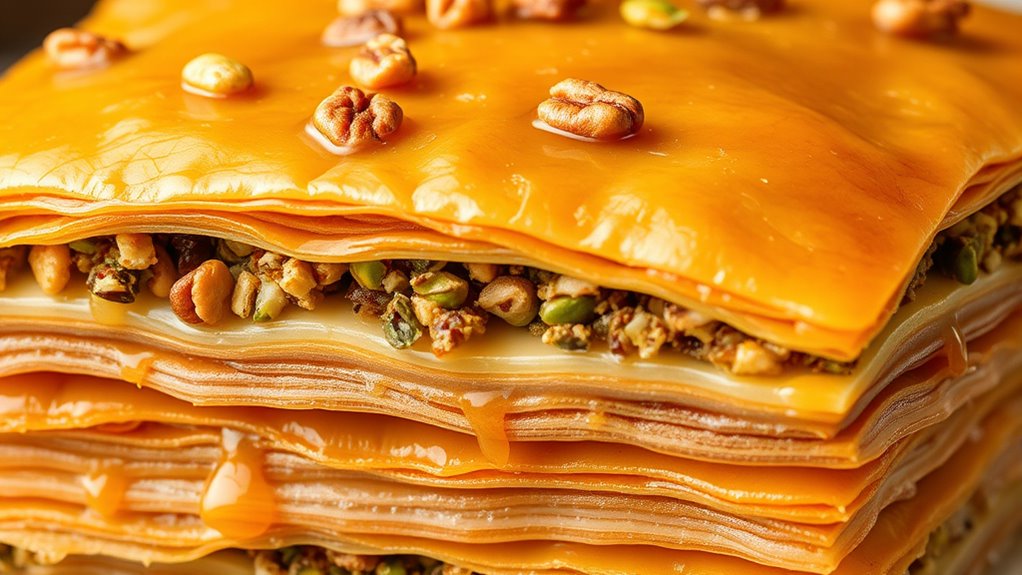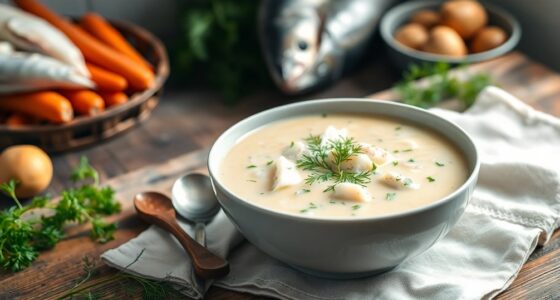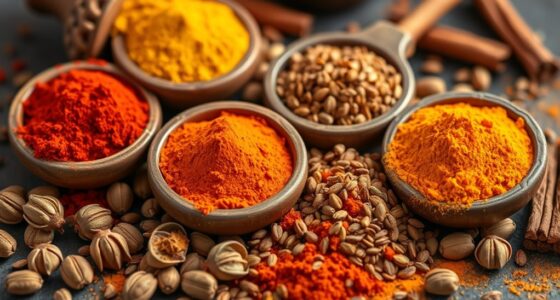Baklava styles vary widely across regions, from thin, crispy layers in Turkey to thicker, syrup-soaked slices in Greece. In the Middle East and Iran, you’ll find fragrant spices and regional nuts like pistachios and walnuts, while Balkan versions often include fruit fillings. Each area uses different techniques for layering, baking, and sweetening—some with honey, others with aromatic syrups. Explore these differences to discover how history and culture shape each unique style. If you keep exploring, you’ll uncover even more regional secrets.
Key Takeaways
- Regional baklava styles differ in layering techniques, with some regions favoring thin, crispy layers while others prefer thicker, syrup-soaked sheets.
- Nut choices like pistachios, walnuts, or almonds vary by region, influencing flavor profiles and filling textures.
- Preparation methods, including dough thickness, glazing techniques, and baking durations, create distinct regional textures and sweetness levels.
- Presentation styles range from individual pieces to elaborate platters, reflecting local aesthetics and cultural traditions.
- Ingredient variations, such as regional spices and flavorings, significantly shape each area’s unique baklava style and taste.
Turkish Baklava: Tradition and Technique
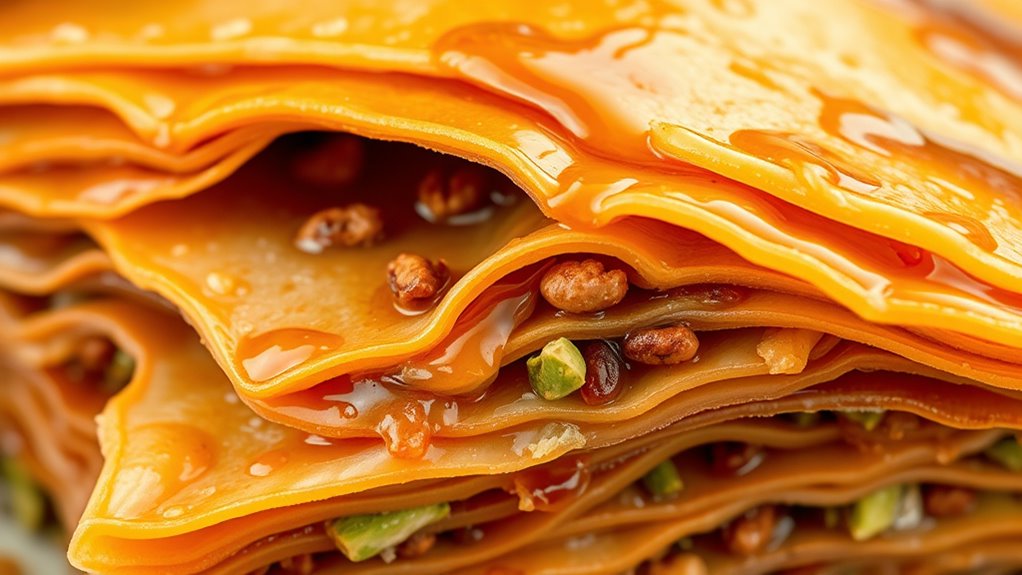
Turkish baklava has long been celebrated as a symbol of culinary artistry, blending tradition with meticulous technique. When making it, you carefully layer thin sheets of phyllo dough, each brushed with melted butter, creating a delicate, flaky texture. The filling, traditionally a mix of finely chopped nuts like pistachios or walnuts, is evenly spread to ensure balanced flavor in every bite. As you assemble the baklava, you follow time-honored methods, pressing the layers together to prevent shifting during baking. Precision matters—cutting the pastry into perfect diamonds or squares guarantees uniform baking and presentation. Additionally, maintaining the right temperature during baking is crucial to achieving the ideal crispness and color. Once baked to a golden hue, you pour warm syrup infused with hints of lemon or rosewater over the hot pastry, allowing it to absorb flavors fully. This careful process highlights Turkish baklava’s rich heritage and craftsmanship. Incorporating butter into each layer enhances flavor and texture, reflecting the importance of quality ingredients in traditional recipes. To ensure the perfect texture, controlling the baking temperature is essential for consistent results.
Greek Baklava: Rich Flavors and Syrup Balance

Greek baklava is renowned for its bold, rich flavors and perfectly balanced syrup, which elevates each bite. You’ll notice the generous use of honey and sometimes lemon zest, creating a deep sweetness that complements the crispy, flaky layers of phyllo dough. The syrup is added just right—not too thick or too runny—so each piece remains moist without becoming soggy. This careful balance highlights the natural nuttiness of fillings like walnuts or almonds, which are often coarsely chopped for texture. The result is a dessert that’s both indulgent and harmonious, with flavors that linger. Greek baklava’s emphasis on syrup balance and robust flavors makes it a memorable treat that highlights the region’s love for bold, sweet, and aromatic desserts. The tradition of using natural ingredients like honey and nuts reflects the historical significance of local resources in shaping regional flavors. Additionally, the use of natural ingredients enhances the authenticity and healthfulness of this cherished dessert.
Middle Eastern Variations: Layers and Nut Choices
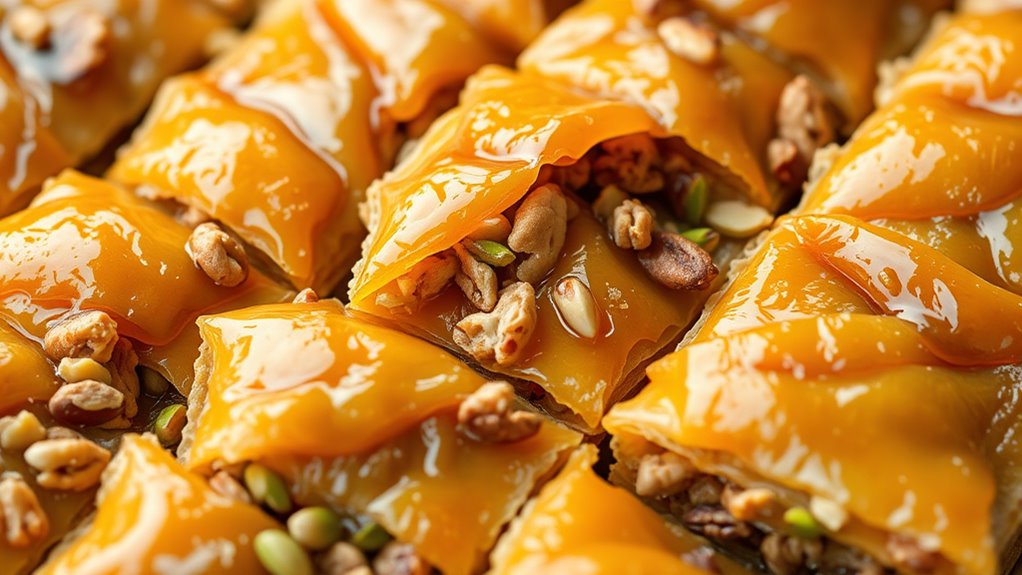
While the core concept of layered phyllo and sweet syrup remains central, Middle Eastern variations introduce unique twists through different layering techniques and nut selections. You might notice thicker layers of phyllo or multiple layers of nuts, creating a denser, more textured bite. Pistachios are the most popular choice, lending a distinctive green hue and rich flavor, but walnuts and almonds also appear, offering varied tastes and textures. Some recipes incorporate crushed pistachios between layers, enhancing crunch and flavor. The nut-to-phyllo ratio varies, influencing sweetness and richness. Additionally, Middle Eastern baklava often features a more generous application of syrup, soaking through the layers to create a moist, sticky finish. These variations highlight regional preferences, emphasizing bold nut flavors and diverse layering techniques. Incorporating sustainable practices in ingredient sourcing can also influence regional baklava recipes, ensuring freshness and supporting local communities. Moreover, payment processing technology can facilitate the distribution and sales of baklava by streamlining online orders and transactions. Furthermore, embracing regional culinary traditions can enrich the authenticity and appeal of the final product. Adding attention to product authenticity ensures that consumers receive genuine, high-quality baklava. Incorporating aesthetic presentation can elevate the visual appeal of baklava, making it more inviting and festive.
Balkan Styles: Sweetness and Texture Differences
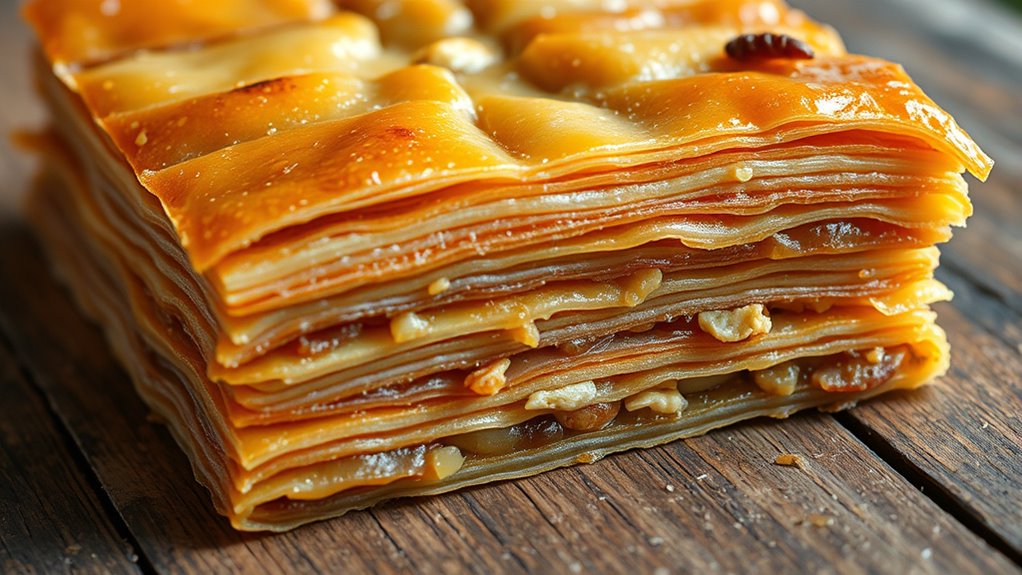
Balkan baklava often features a different syrup consistency, making it less sticky and more balanced in sweetness. You’ll notice the variety of nut and fruit fillings, which add unique textures and flavors compared to other styles. These differences give Balkan baklava its distinctive taste and mouthfeel. Additionally, the use of regional ingredients and essential oils can subtly influence the flavor profile of the dessert. The regional variations in preparation methods also reflect local culinary traditions, enhancing the diversity of Balkan baklava. Incorporating traditional baking techniques further distinguishes Balkan baklava from other regional varieties.
Syrup Thickness Variations
Syrup thickness plays a essential role in shaping the final texture and sweetness of baklava, especially in Balkan styles where regional variations are prominent. Thicker syrups tend to make the pastry more moist, sticky, and intensely sweet, creating a rich mouthfeel. In contrast, thinner syrups absorb more quickly, resulting in a lighter, less cloying finish. Balkan baklava often features a medium to thick syrup that soaks into the layers, ensuring each bite is flavorful and moist without becoming overly soggy. The consistency of the syrup also influences how long the dessert stays fresh, with thicker syrups helping it maintain its texture longer. Adjusting the syrup thickness allows baklava makers to tailor the sweetness and moisture to regional preferences and personal tastes.
Nut and Fruit Fillings
Have you noticed how nut and fruit fillings vary in sweetness and texture across different Balkan baklava styles? In some regions, fillings are rich and moist, made with finely chopped walnuts, pistachios, or almonds, offering a creamy, melt-in-your-mouth feel. Others prefer coarser textures, with larger nut pieces that add crunch and bite. The sweetness level also differs: some styles feature a lightly sweetened mixture that balances the natural nuttiness, while others use syrup-soaked fillings that are intensely sweet. Fruit fillings, like apricots or cherries, introduce a tangy or tart contrast, often combined with nuts for added texture. These regional variations reflect local tastes and available ingredients, giving each Balkan style its unique flavor profile and mouthfeel. Additionally, the use of natural materials like honey or fruit preserves can influence the overall sweetness and moisture content of the fillings.
Iranian and Central Asian Twists on Baklava
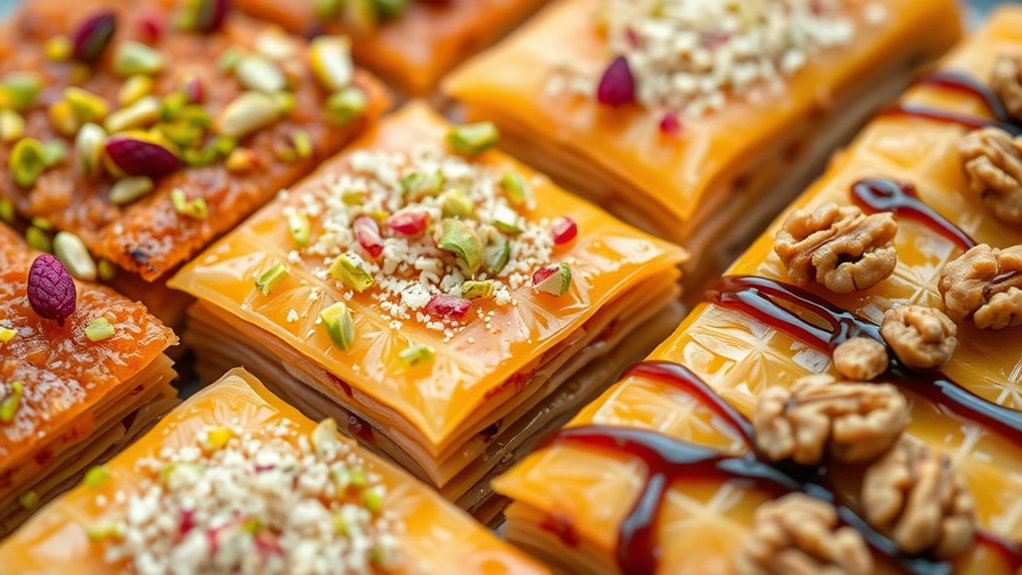
Iranian and Central Asian baklava often feature unique fillings like pistachios, walnuts, and fragrant spices that set them apart. They also use distinct preparation techniques, such as layering dough more thinly or adding syrup at different stages. These variations create a rich tapestry of flavors and textures worth exploring. Additionally, incorporating regional ingredients in the layering process can influence the texture and presentation of the final product. Employing traditional techniques can further enhance the authenticity and complexity of the baklava. Embracing mindful food preparation practices can enhance the culinary experience and respect regional traditions. Understanding culinary heritage helps preserve the unique characteristics of these regional styles.
Unique Filling Variations
While traditional baklava is often filled with chopped nuts and sweetened with honey or syrup, Iranian and Central Asian variations introduce intriguing twists that set them apart. In Iran, pistachios and almonds dominate, sometimes combined with fragrant spices like cardamom or rosewater, creating a richer, more aromatic filling. Central Asian versions often incorporate dried fruits such as apricots, raisins, or quince, adding natural sweetness and texture. Some recipes blend walnuts with cinnamon or add sesame seeds for a nutty crunch. These regional fillings reflect local flavors and agricultural products, giving each variation a distinct character. Instead of a uniform nut filling, you get a spectrum of tastes—from floral and fruity to spicy and earthy—highlighting the diversity within baklava’s traditional framework. Regional culinary influences play a significant role in shaping these unique variations.
Distinct Preparation Techniques
Iranian and Central Asian baklava showcase distinctive preparation techniques that set them apart from the traditional Greek or Turkish versions. In these styles, you might layer the phyllo dough differently, often using a thicker or more textured dough to create a denser, chewier texture. You’ll also notice unique glazing methods—some recipes involve brushing each layer with honey or syrup before baking, resulting in a glossy finish and enhanced sweetness. Additionally, the filling preparation may differ; nuts are sometimes coarsely chopped or mixed with spices like cardamom, then spread more generously between layers. You may also find that the baking process is longer or at slightly different temperatures, giving these baklava styles their characteristic chewy, sticky consistency that’s distinct from their Western counterparts.
North African Inspirations and Unique Ingredients
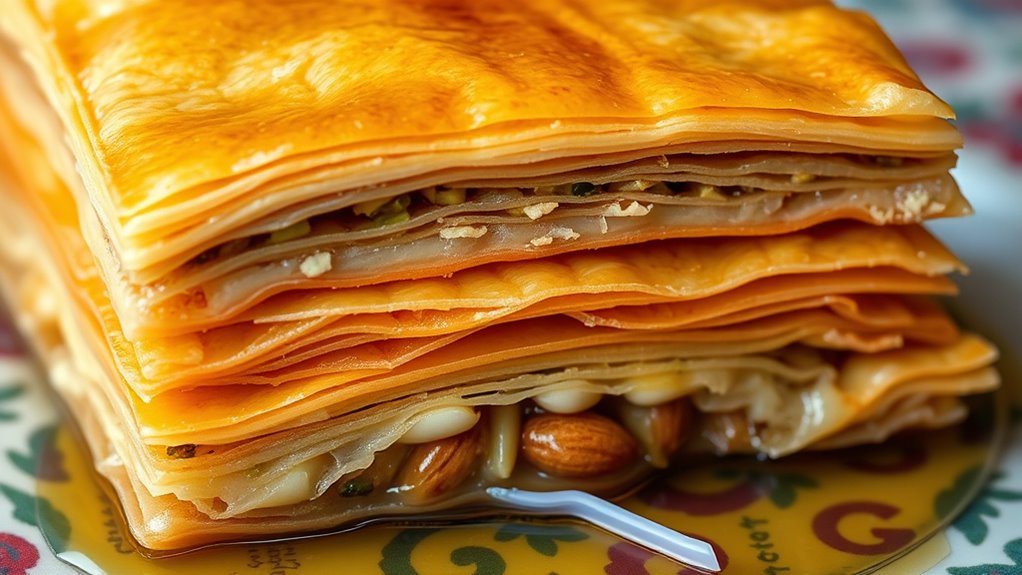
North African culinary traditions bring a vibrant array of flavors and ingredients to baklava, setting it apart from other regional variations. You’ll notice the use of aromatic spices like cinnamon, cardamom, and sometimes cloves, adding warmth and depth. Unique ingredients such as orange blossom water and rose water infuse the syrup, giving the pastry a fragrant, floral note. In some regions, ingredients like pistachios, almonds, or even walnuts are layered generously, creating rich textures. Honey often replaces simple sugar syrup, enhancing sweetness and complexity. You’ll also see the incorporation of local ingredients like sesame seeds or dates, adding a distinctive regional touch. These ingredients and flavors reflect North Africa’s rich history of trade and culinary exchange, making their baklava uniquely fragrant and flavorful. Additionally, traditional baking techniques contribute to the texture and presentation that distinguish North African baklava from other styles.
Armenian and Georgian Approaches to Baklava
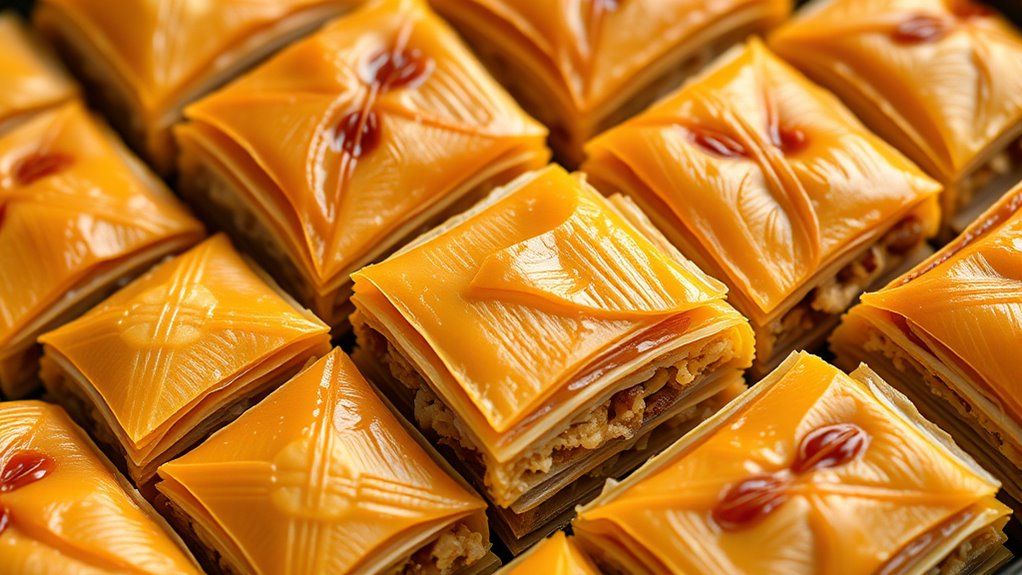
Armenian and Georgian baklava showcase distinct techniques and flavor profiles that reflect their rich culinary traditions. Armenian baklava often features finely chopped nuts, such as walnuts or pistachios, layered between thin phyllo sheets, then soaked in honey syrup, creating a sweet, sticky finish. The pastry is typically cut into diamond or square shapes, emphasizing its crisp texture. Georgian baklava, meanwhile, tends to incorporate local ingredients like walnuts, almonds, and sometimes dried fruits. It often uses a denser, more cake-like dough or layered phyllo, with a focus on aromatic spices like cinnamon and cloves. Georgian baklava may be topped with crushed nuts or honey glaze, offering a richer, more robust flavor. Both styles celebrate regional ingredients and techniques, resulting in unique, region-specific interpretations of baklava. Additionally, the use of aromatic spices in Georgian baklava enhances its distinctive flavor profile, setting it apart from the Armenian style. Incorporating traditional baking methods further highlights the cultural significance of each regional variation. The choice of baking techniques can also influence the final texture and flavor of the pastry, making each version uniquely tied to its cultural origins. Moreover, the attention to detail in preparation underscores the importance of tradition in each culinary approach. Emphasizing culinary heritage, each style reflects the history and identity of its region through its unique ingredients and methods.
Modern Fusion Styles: Innovation in Layers and Fillings
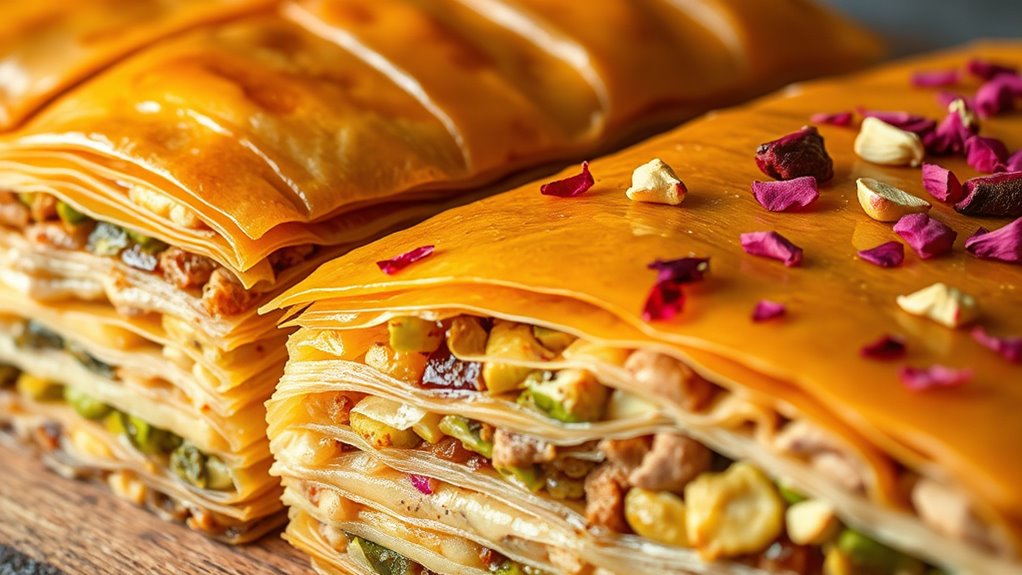
Modern baklava styles push boundaries with creative layer arrangements and unexpected fillings. You might encounter combinations like pistachios with chocolate or exotic fruits layered between crispy sheets. These fusion flavors bring fresh excitement to a classic treat, inspiring you to experiment with your own twists.
Creative Layer Arrangements
Innovative layer arrangements breathe new life into traditional baklava, blending flavors and textures in unexpected ways. You can experiment with stacking different types of phyllo dough or layering nuts and spices to create visual interest and varied mouthfeels. Some baklava artists incorporate multiple thin layers, alternating sweet syrup-soaked sheets with crunchy nut layers, producing a complex texture profile. Others introduce a mosaic of colors by layering tinted or flavored doughs, making the pastry as eye-catching as it is delicious. You might also arrange layers asymmetrically for a modern, artistic presentation. These creative approaches challenge the conventional uniform layering, encouraging you to explore new combinations and designs that elevate baklava beyond traditional boundaries. The result is a unique, memorable dessert that showcases your personal style and innovation.
Unconventional Fillings
Have you ever considered pushing the boundaries of traditional baklava by incorporating unconventional fillings? Modern fusion styles explore beyond nuts and honey, adding exciting new flavors and textures. These innovative fillings challenge conventions and open new culinary possibilities. For example:
- Fresh fruits like berries or citrus zest for a burst of acidity
- Cream cheese or mascarpone for richness and creaminess
- Chocolate or caramel for decadence and depth
- Savory ingredients like cheese, herbs, or spiced meats for unexpected twists
These fillings can transform baklava into a versatile dessert or snack, appealing to diverse palates. Embracing unconventional ingredients allows you to experiment with flavor profiles, creating unique layers that surprise and delight. It’s a bold step towards redefining what baklava can be.
Fusion Flavor Combinations
Fusion flavor combinations in baklava open up exciting possibilities by blending diverse culinary traditions into a single layered dessert. You might try adding unexpected ingredients like matcha, cardamom, or even exotic fruits to traditional nut fillings. This innovation allows you to create unique flavor profiles that surprise and delight. Combining flavors from different regions—such as Middle Eastern spices with Asian teas or Mediterranean herbs—enhances the complexity of your baklava. Layering these new fillings between crispy phyllo sheets results in a stunning, multi-dimensional treat. Experimenting with fusion styles lets you personalize your baklava, making it both a cultural mosaic and a culinary masterpiece. It’s an exciting way to honor tradition while pushing creative boundaries in flavor and presentation.
Regional Variations in Preparation and Presentation
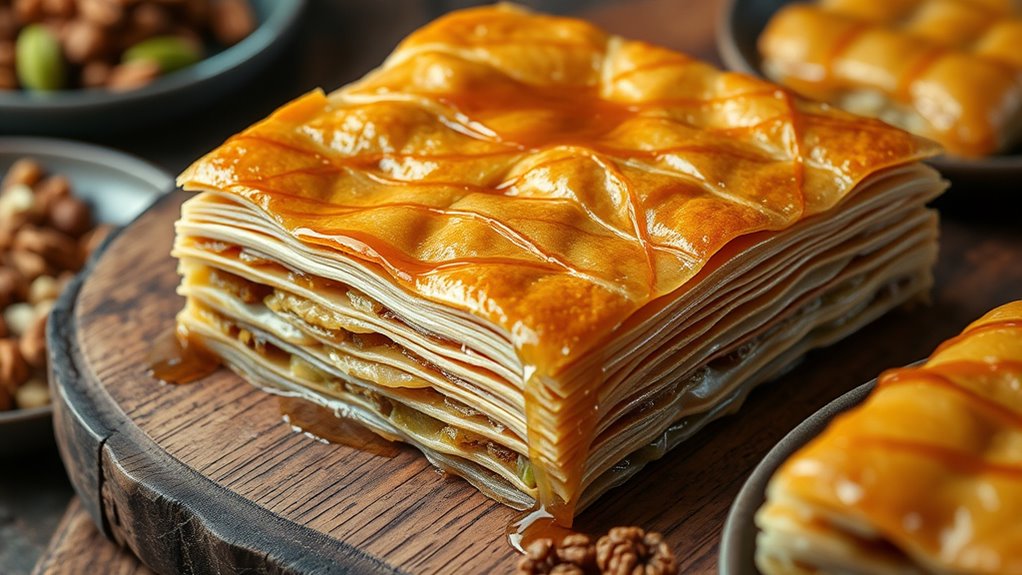
Regional variations in baklava preparation and presentation highlight the rich diversity across cultures. Depending on where you are, you’ll notice differences in ingredients, layering techniques, and serving styles. For example, some regions prefer thin, crispy layers, while others favor thicker, more syrup-soaked slices. Presentation can also vary from individual pieces to large, ornate platters. These differences reflect local tastes, available ingredients, and cultural traditions. By exploring these variations, you can appreciate how baklava adapts to its environment and cultural identity.
- Layer thickness and number influence texture and flavor intensity
- Use of nuts varies, with some regions favoring pistachios, others walnuts or almonds
- Shape and serving style range from rolled, triangular, to square pieces
- Decoration and garnishes often reflect local aesthetics and customs
Comparing Sweeteners: Honey, Syrup, and Other Natural Additions
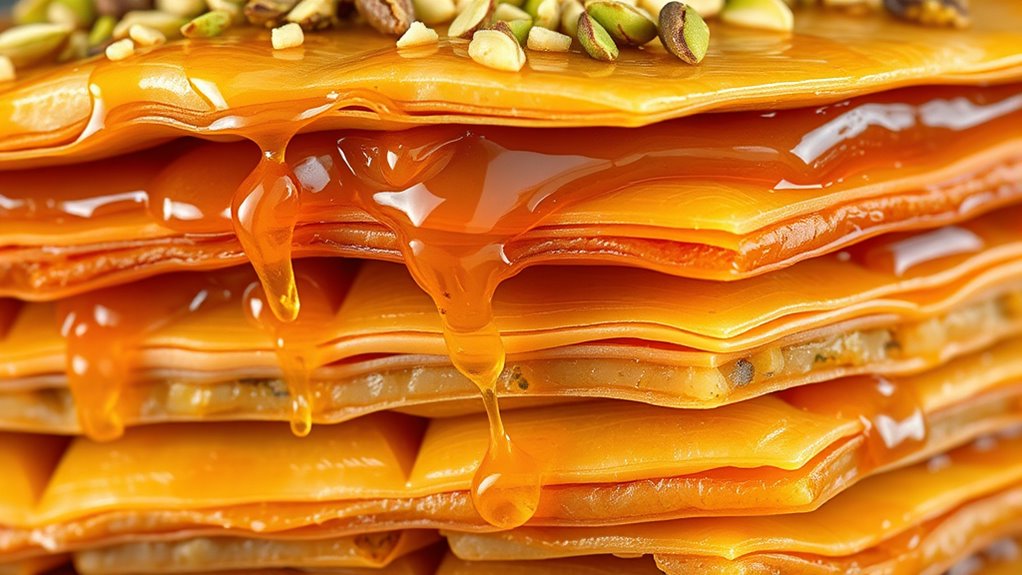
Sweeteners play a essential role in defining the flavor and texture of baklava, and choosing the right one can considerably influence the final product. Honey is the most traditional choice, imparting a rich, floral sweetness and a sticky, glossy finish. Syrups, often made from sugar, water, and lemon juice, provide a smooth, sweet glaze that seeps into the layers, enhancing moisture and shelf life. Some regional variations include using fruit syrups or molasses for deeper, more robust flavors. Other natural additions, like orange blossom water or rose water, complement the sweetness and add aromatic complexity. Your choice of sweetener affects not only taste but also the appearance and texture, so consider the flavor profile you desire and regional authenticity when selecting the perfect sweetener for your baklava.
Frequently Asked Questions
How Do Regional Climates Influence Baklava Ingredient Choices?
Regional climates directly influence the ingredients you choose for baklava. In drier areas, you might prefer using more honey or syrup for moisture, while in humid regions, lighter syrups help prevent sogginess. Warmer climates may lead you to select ingredients that resist spoilage, like preserved nuts or dried fruits. These climate-driven choices shape the flavor, texture, and overall quality of your baklava, making each regional style unique.
What Are Common Decorative Techniques Across Different Baklava Styles?
Imagine delicate, shimmering patterns adorning every piece of baklava, turning each into a tiny masterpiece. Across styles, you’ll see techniques like intricate piping, sprinkling crushed nuts, or drizzling honey with artistic flair. These decorations aren’t just for beauty—they celebrate regional culture and craftsmanship. No matter where you taste it, these decorative touches make baklava a visual feast, elevating every bite into a stunning, edible artwork.
How Do Traditional Baklava Recipes Vary With Cultural Celebrations?
When you explore traditional baklava recipes, you’ll notice they vary based on cultural celebrations. For instance, during Eid, you might find more elaborate, honey-glazed varieties, while Turkish festivities often feature nut-rich, layered versions. In Greece, olive oil replaces butter, giving a distinct flavor. These differences reflect local ingredients and customs, making each baklava celebration unique and special. You get to savor these regional nuances in every sweet bite.
Are There Specific Tools Unique to Each Regional Baklava Preparation?
Think of regional baklava tools as a chef’s secret arsenal. You might use a special wooden mold in the Middle East to shape the layers perfectly, while in Greece, a fine serrated knife helps create delicate cuts. Some regions employ unique brushes for syrup application, and rolling pins might have regional carvings. These tools reflect local traditions, making each baklava style distinct like a fingerprint.
How Has Modern Technology Impacted Baklava Baking Methods Worldwide?
Modern technology has greatly changed how you bake baklava worldwide. You now have access to advanced ovens that guarantee even baking, and digital timers help perfect timing. You can use food processors to finely chop nuts quickly, saving time. Online tutorials and recipes allow you to learn new techniques and styles instantly. These innovations make your baking more precise, efficient, and consistent, helping you create delicious baklava no matter where you are.
Conclusion
No matter where you try it, baklava showcases a fascinating blend of regional flavors and techniques. Did you know that Turkey produces over 300,000 tons of baklava annually? As you explore these styles, you’ll notice how each region’s unique ingredients and traditions create a deliciously diverse dessert. So, next time you indulge, appreciate the rich history and cultural twists behind every flaky, sweet layer you enjoy.
